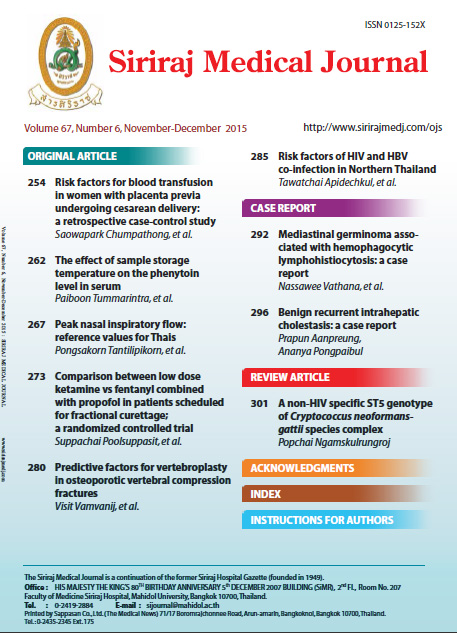Benign Recurrent Intrahepatic Cholestasis: A Case Report
Abstract
Benign recurrent intrahepatic cholestasis (BRIC) is an autosomal recessive cholestatic liver disease. Recurrent self-limited episodes of jaundice and severe pruritus are leading clinical manifestations. We report a 16-year-old Thai boy with three recurrent episodes of cholestasis. The first episode occurred at 30 months old. The subsequent recurrent episodes were at 13 and 16 years, respectively. Investigations including viral study, autoimmune hepatitis markers, abdominal ultrasound and magnetic resonance cholangiopancreatography (MRCP) were negative. Diagnosis of BRIC was made based on specific criteria. He was treated with cholestyramine and ursodeoxycholic acid when the first and second episodes occurred which resulted in good recovery. However, for the last recurrent episode, treatment with ursodeoxycholic acid failed to improve his condition, so his treatment was changed to rifampicin, which resulted in dramatic response. Although BRIC is a rare disease, it should be taken into account in all cases with recurrent cholestasis with normal or minimally elevated GGT level. Currently, genetic study for the mutation of ATP8B1 and ABCB11 genes are crucial for making a definite diagnosis.
Keywords: Cholestasis, severe pruritus, ATP8B1, ABCB11, gene mutationDownloads
Published
How to Cite
Issue
Section
License
Authors who publish with this journal agree to the following conditions:
Copyright Transfer
In submitting a manuscript, the authors acknowledge that the work will become the copyrighted property of Siriraj Medical Journal upon publication.
License
Articles are licensed under a Creative Commons Attribution-NonCommercial-NoDerivatives 4.0 International License (CC BY-NC-ND 4.0). This license allows for the sharing of the work for non-commercial purposes with proper attribution to the authors and the journal. However, it does not permit modifications or the creation of derivative works.
Sharing and Access
Authors are encouraged to share their article on their personal or institutional websites and through other non-commercial platforms. Doing so can increase readership and citations.










